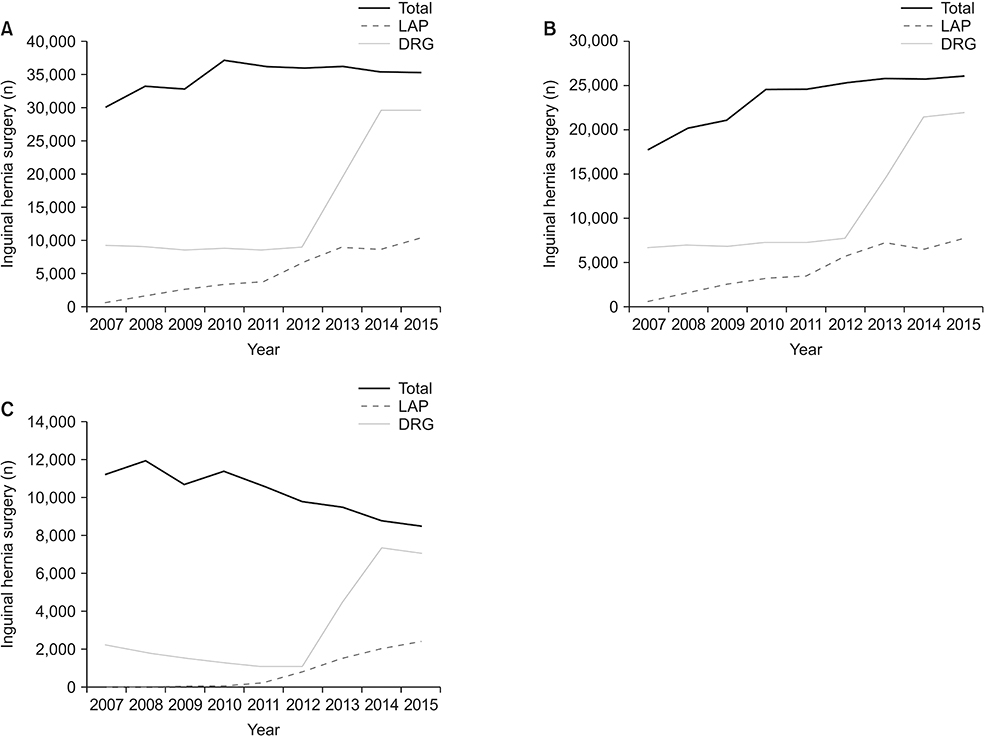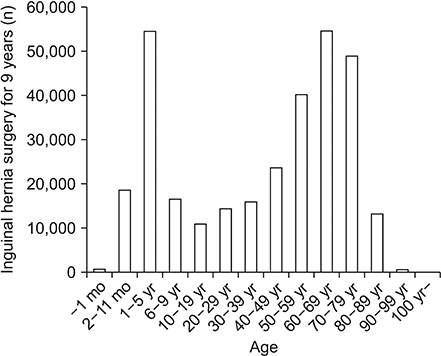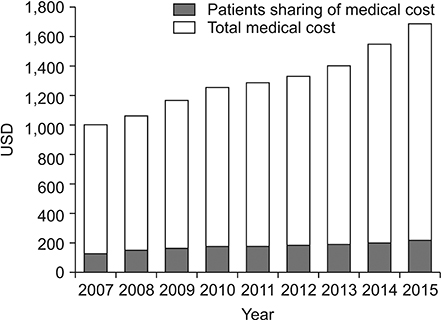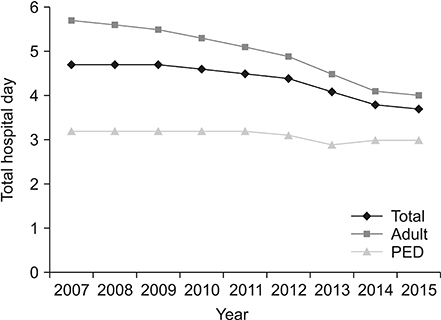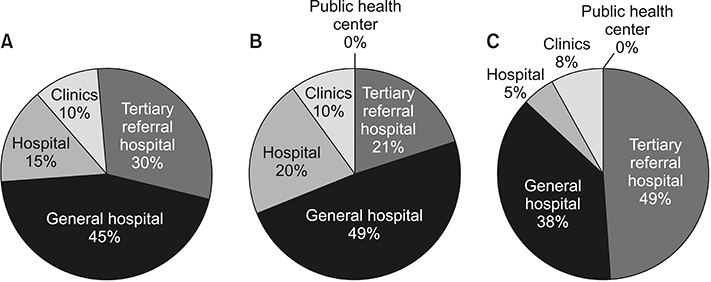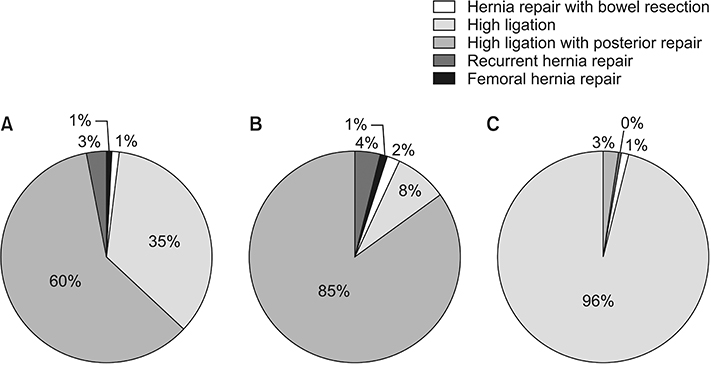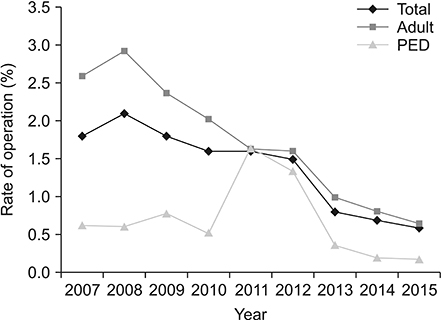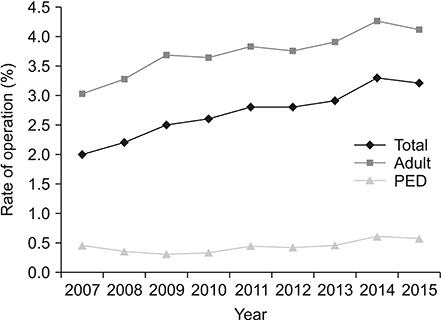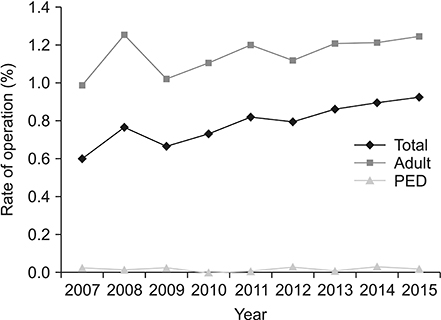Ann Surg Treat Res.
2019 Jul;97(1):41-47. 10.4174/astr.2019.97.1.41.
Inguinal hernia surgery in Korea: nationwide data from 2007–2015
- Affiliations
-
- 1Department of Surgery, St. Vincent's Hospital, College of Medicine, The Catholic University of Korea, Suwon, Korea. hj@catholic.ac.kr
- KMID: 2450989
- DOI: http://doi.org/10.4174/astr.2019.97.1.41
Abstract
- PURPOSE
The aim of this study is to analyze inguinal hernia in Korea based on the nationwide data.
METHODS
Retrospective analysis of nationwide data obtained from the Health Insurance Review & Assessment Service database for surgical repair of inguinal hernia from January, 2007 to December, 2015 was performed.
RESULTS
A total of 314,238 cases of inguinal hernia surgery were performed during 9 years. The mean number of inguinal hernia surgery per year was 34,604 (range, 30,065-36,928). The proportion of male patient was 87%. Patients between the age of 1 to 5 years (17.3%) and of 60 to 69 years (17.4%) constituted the 2 dominant groups for inguinal hernia repair. A slight increase in repair for recurrent inguinal hernia, 1.9% to 3.2%, was observed from 2007 to 2015. The rate of concurrent bowel resection decreased from 1.9% to 0.6%. The total cost of inguinal hernia surgery was increased up to 1.68 times from 2007 to 2015 ($856 to $1,439), although the number of hospital days was decreased from 4.7 to 3.7 days. The rate of laparoscopic surgery was increased to 29.5% in 2015.
CONCLUSION
A mean number of 34,604 cases of inguinal hernia surgery have been carried out annually in Korea. The age distribution for inguinal hernia repair demonstrates bimodal peak at early childhood and old age. The proportion of laparoscopic surgery of inguinal hernia has been increasing for the past 9 years. The length of hospital stay and the rate of combined bowel resection have decreased.
MeSH Terms
Figure
Cited by 1 articles
-
Chronological trends in patients undergoing cholecystectomy in Korea: a nationwide health insurance claims study
Chul Hyo Jeon, Jinwook Hong, Jaehun Jung, Jong Youn Moon, Ho Seok Seo
Ann Surg Treat Res. 2022;102(4):205-213. doi: 10.4174/astr.2022.102.4.205.
Reference
-
1. Bay-Nielsen M, Kehlet H, Strand L, Malmstrom J, Andersen FH, Wara P, et al. Quality assessment of 26,304 herniorrhaphies in Denmark: a prospective nationwide study. Lancet. 2001; 358:1124–1128.
Article2. Rutkow IM. Demographic and socioeconomic aspects of hernia repair in the United States in 2003. Surg Clin North Am. 2003; 83:1045–1051.
Article3. Beard JH, Oresanya LB, Ohene-Yeboah M, Dicker RA, Harris HW. Characterizing the global burden of surgical disease: a method to estimate inguinal hernia epidemiology in Ghana. World J Surg. 2013; 37:498–503.
Article4. Kwon S, Lee TJ, Kim CY. Republic of Korea health system review. Geneva (Switzerland): World Health Organization;2015.5. Burcharth J, Pedersen M, Bisgaard T, Pedersen C, Rosenberg J. Nationwide prevalence of groin hernia repair. PLoS One. 2013; 8:e54367.
Article6. Wara P, Bay-Nielsen M, Juul P, Bendix J, Kehlet H. Prospective nationwide analysis of laparoscopic versus Lichtenstein repair of inguinal hernia. Br J Surg. 2005; 92:1277–1281.
Article7. Park SJ, Lee KY, Lee SH. Laparoscopic surgery for colorectal cancer in Korea: nationwide data from 2008–2013. J Minim Invasive Surg. 2015; 18:39–43.
Article8. McCormack K, Scott NW, Go PM, Ross S, Grant AM. EU Hernia Trialists Collaboration. Laparoscopic techniques versus open techniques for inguinal hernia repair. Cochrane Database Syst Rev. 2003; (1):CD001785.
Article9. Eklund A, Carlsson P, Rosenblad A, Montgomery A, Bergkvist L, Rudberg C, et al. Long-term cost-minimization analysis comparing laparoscopic with open (Lichtenstein) inguinal hernia repair. Br J Surg. 2010; 97:765–771.10. Oberg S, Andresen K, Rosenberg J. Etiology of inguinal hernias: a comprehensive review. Front Surg. 2017; 4:52.
Article11. Pan ML, Chang WP, Lee HC, Tsai HL, Liu CS, Liou DM, et al. A longitudinal cohort study of incidence rates of inguinal hernia repair in 0- to 6-year-old children. J Pediatr Surg. 2013; 48:2327–2331.
Article12. Puri P, Guiney EJ, O'Donnell B. Inguinal hernia in infants: the fate of the testis following incarceration. J Pediatr Surg. 1984; 19:44–46.
Article13. Burcharth J, Andresen K, Pommergaard HC, Bisgaard T, Rosenberg J. Recurrence patterns of direct and indirect inguinal hernias in a nationwide population in Denmark. Surgery. 2014; 155:173–177.
Article14. Burcharth J. The epidemiology and risk factors for recurrence after inguinal hernia surgery. Dan Med J. 2014; 61:B4846.
- Full Text Links
- Actions
-
Cited
- CITED
-
- Close
- Share
- Similar articles
-
- Amyand's Hernia with Periappendicular Abscess
- Nationwide big data analysis of inguinal hernia surgery trends in South Korea (2016–2022)
- An Adult Right-sided Bochdalek Hernia Accompanied with Hepatic Hypoplasia and Inguinal Hernia
- Clinical Characteristics of Inguinal Hernia in Children on Peritoneal Dialysis
- Clinical Study of Contralateral Inguinal Hernia Development in Children with Unilateral Inguinal Hernia

